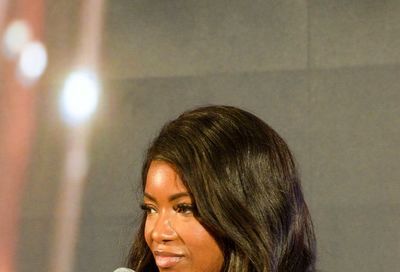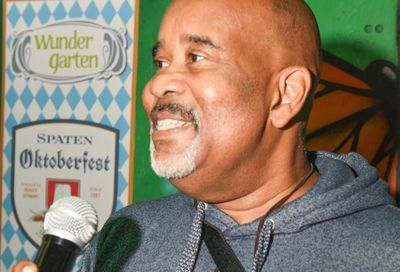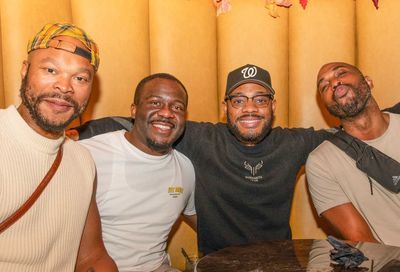In what may have been exactly the sort of politically star-studded event the recently deceased Bob Hattoy would have appreciated — and, some would argue, expected — friends, family and admirers of Hattoy gathered Wednesday evening, April 18, in a room of the Capitol to celebrate his life and share their stories of him, from the silly to the sentimental.
Hattoy, who came to the fore of the American consciousness by giving a televised, prime-time speech at the 1992 Democratic National Convention in New York in which he addressed the nation as a gay man with AIDS, died of AIDS-related illness March 4. He was 56.

Hillary Clinton
(Photo by Ward Morrison) |
To an audience of about 75 people, Sen. Hillary Clinton (D-N.Y.), recalled spotting Hattoy in the back of a stodgy audience she addressed during her husband’s presidential campaign in 1992. ”I look back, and there’s Bob … kind of back there moving to the beat of his own music,” Clinton remembered, adding that Hattoy then pulled out a cigarette lighter, holding it above his head, lit, as he swayed in rock-concert fashion.
House Speaker Nancy Pelosi (D-Calif.), who traces her friendship with Hattoy back to competing against him during her first congressional race in 1987, shared Hattoy’s response to Clinton’s 1996 book, It Takes A Village: ”It
takes the Village People.” To which Pelosi added, ”That’s about the end of the stories I can tell,” implying Hattoy’s bawdy reputation.
”We’re just going to miss him terribly, but he left us a great legacy,” Pelosi summed, to much applause, thanking the longtime environmentalist Hattoy for his part in keeping California’s coastline free of offshore oil drilling and lauding his ”intense patriotism.” After leaving the Clinton White House in 1999, Hattoy returned to California, where he worked for the California Fish and Game Commission. A few weeks before his death, he was appointed president of the commission.
Sen. Barbara Boxer (D-Calif.) also joined the celebration, telling how during a beachfront party, Hattoy tried to escort her away from a group of naturists before she spotted them.
D.C. Councilmember Carol Schwartz (R-At large) offered evidence that Hattoy, while staunchly Democratic, could cross the aisle by supporting her, despite her GOP affiliation. Cornelius Baker, who has worked for both Schwartz and the elder Bush’s presidential administration, added similar sentiments.
”He was partisan, but never petty,” Baker insisted, recalling countless martini-fueled Thursday evenings with Hattoy in the 1990s at Trumpets, a since-closed D.C. gay bar. ”I just felt so happy to know him, and grateful for his love and friendship.”

House Speaker Nancy Pelosi receives a photo of Bob Hattoy
(Photo by Ward Morrison) |
Aside from Schwartz and Baker, several other faces familiar to the local GLBT community were in attendance, such at Team D.C. President Brent Minor; Atlas Events’ Mark Lee; Julie Scofield, executive director of the National Alliance of State & Territorial AIDS Directors; Donald Hitchcock, former director of the Democratic National Committee’s Gay and Lesbian Leadership Council; his partner, Paul Yandura; his DNC replacement, Brian Bond; and Paul Kawata, director of the National Minority AIDS Council.
David Harvey, another local, who heads the AIDS Alliance for Children, Youth & Families, helped present the celebration along with two men very close to Hattoy, Bob Pelham and Dr. Allen Huff. Along with Harvey, Bond and Yandura, Adrianna Shea and Bellen Joyner were given special mention for helping to organize the celebration.
Pelham and Harvey introduced most of the speakers at the hour-and-a-half celebration, including a group of women upon whom Hattoy reportedly depended while working in the Clinton White House: Dee Dee Myers, President Bill Clinton’s press secretary; Sandy Thurman, his director of national AIDS policy; and Marsha Scott, his liaison to the gay community. To Hattoy, they were lovingly known by a collective moniker, ”the Blondes.”
The blonde Myers delivered some of the most endearing comments of the evening, thanks, in part, to her impersonations of Hattoy. Her most engaging story was her retelling of Hattoy’s crossing the Clinton White House with remarks to a New York Times reporter in regard to gays in the military. That his comments ended up on Page 1 guaranteed a reprimand from Myers, charged with keeping appointees in line.
”Is this what the woodshed looks like?” Hattoy exclaimed, in Myers’ impersonation of him entering her office for the lecture.
Scott told those gathered that it was Hattoy’s irreverence and sense of humor that often saved him from more serious repercussions, allowing him to make his would-be disciplinarians characters in his personal ”comic opera.”
She joked, however, ”I had to protect his job on a nearly daily basis.”
The best comments of the evening, however, were made by Hattoy himself, during a video montage that closed out the celebration. Between photos spanning Hattoy’s life, heavy with shots of him smiling on trips around the world, were quotes that left his audience in stitches. Among the best: ”I didn’t come to Washington to become a faceless bureaucrat. I came to Washington to be a bureaucrat in your face.”
The Bob Hattoy Memorial Fund has been created to support causes important to Hattoy. Donations may be sent care of the Liberty Hill Foundation, 2121 Cloverfield Blvd., Suite 113, Santa Monica, Calif., 90404.


























